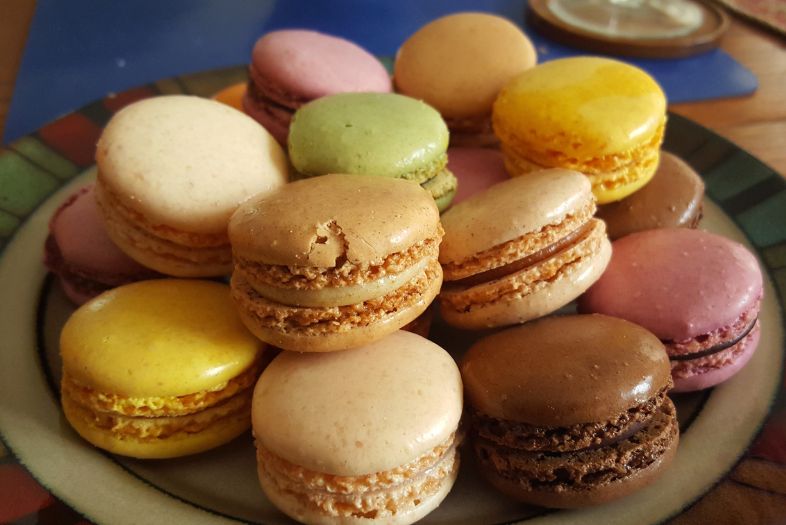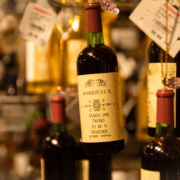
Macaron of Saint-Émilion: elegance and flavour in every mouthful
In the heart of the picturesque Bordeaux wine region, where vineyards are intertwined with history, lies a gastronomic treasure that captivates the most refined palates: the macaron of Saint-Émilion. This exquisite sweet, more than just a dessert, is a culinary masterpiece, an emblem of the elegance and taste that defines this famous French town.
This delicacy, with its crunchy outside and softly tender inside, offers a unique sensory experience. It takes those who taste it on a voyage of discovery through traditions that have endured through the centuries. Every bite of this delicacy is a tribute to the skill and passion of local artisans, who have perfected the recipe over generations.
In this article, we invite you to discover the history, secrets and magic behind the Saint-Émilion macaron. If you want to find out more about its production and history, we invite you to take a free tour of Saint-Émilion.
History and origin of the Macaron of Saint-Émilion
The history of the macaron of Saint-Émilion is intertwined with the cultural and oenological richness of this French region.
For visitors embarking on a Saint-Émilion, exploring its cobbled streets and historic monuments, wine tasting in Saint-Émilion is an unmissable experience. However, equally unmissable is the discovery of macarons, a delicacy that has become a symbol of Bordeaux gastronomy.
When wondering what to see in Saint Émilion, many are surprised to find that, in addition to its breathtaking views and exquisite wines, macarons hold a special place in the heart of the region.
The origins of this sweet treat go back several centuries. The nuns of the Ursuline order, who settled here, began making these little cakes with simple ingredients: almonds, sugar and egg whites. These early macarons were more than a dessert, they were a means of subsistence for the nuns and a reflection of their dedication and skill.
Over time, the macaron has evolved, maintaining its essence but adapting to changing tastes. Originally, these sweets were simpler and less ornate than contemporary colourful and filled versions found in other regions of France.
In Saint-Émilion, the macaron has remained true to its traditional recipe, valuing the quality of its ingredients and the mastery of its preparation over ostentation.
Among the local anecdotes, it is said that each macaron shop in Saint-Émilion has its own slightly different version of the recipe. Visitors often find themselves in a friendly debate over which pastry shop offers the most authentic and delicious macaron.
Ingredients and preparation
The macaron is a culinary delight that is well worth a visit to Saint Emilion. This iconic sweet, typical of one of the pretty villages near Bordeaux, stands out for its exquisite taste and the simplicity and quality of its ingredients. Here’s how this traditional dessert is made and what sets it apart from other types of macarons.
Traditional ingredients
- Ground almonds: provide a rich texture and deep flavour.
- Sugar: adds sweetness and contributes to the crunchy texture.
- Egg whites: used to create the airy, light structure of the macaron.
Step-by-step process
- Mix the dry ingredients: sieve and mix the ground almonds with the sugar.
- Whisk the egg whites: beat them until stiff, which aerates them.
- Fold in the ingredients: the beaten egg whites are carefully combined with the almond and sugar mixture, keeping the structure airy.
- Form the macarons: using a piping bag, form small circles on a prepared baking tray.
- Bake: bake at a low temperature to maintain a crunchy outside and soft inside.
- Cool and serve: once cooled, the macarons are ready to be enjoyed.
Differences from other types of macarons
Unlike the colourful and filling Parisian macarons, the Saint-Émilion macaron stays true to its more traditional and simpler form. They have no fillings or colourings, focusing on the quality and natural flavour of their ingredients. This simplicity is what makes them unique and reflects the essence of traditional French pastry-making.
The Saint-Émilion macaron, with its authentic taste and unique texture, is a testament to the rich gastronomic culture of the region. It also serves as a reminder that sometimes in simplicity lies true elegance.
Cultural importance
The macaron of Saint-Émilion is not just a dessert, it is an icon of the rich regional gastronomy and a cultural emblem of both Saint-Émilion and France in general. This sweet, with its history woven into the traditions and heritage of the region, represents much more than a simple delicacy; it is a symbol of local identity and history.
In France, a country known for its exquisite gastronomy and deep respect for culinary traditions, the macaron has a special place. It is a testament to the craftsmanship and dedication to quality that characterise French cuisine. In this village, this dessert is not only a source of local pride, but also an element of connection with the history and roots of the community.
The macaron takes centre stage at various events and festivals in and around Saint-Émilion. During these festivities, macarons are tasted and take part in competitions, cooking workshops and celebrations. For example, at local fairs and markets, they are presented in various forms, offering visitors a glimpse of the versatility and creativity of local confectioners.



